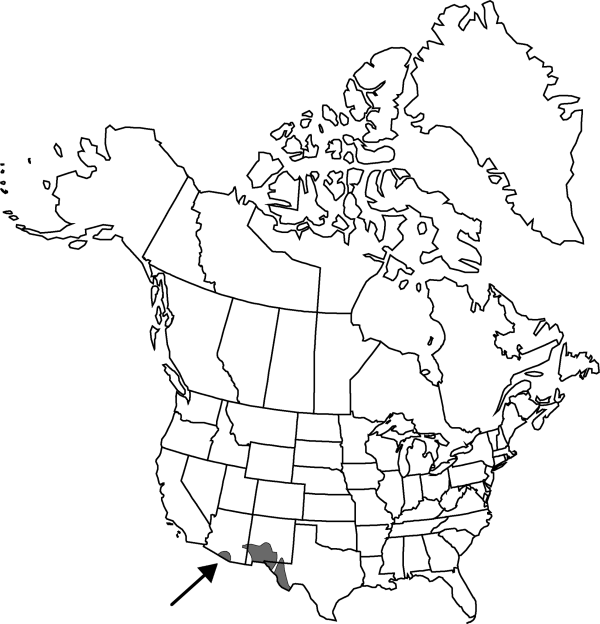Difference between revisions of "Coryphantha robustispina"
Cact. 4: 33. 1923.
FNA>Volume Importer |
FNA>Volume Importer |
Revision as of 20:00, 24 September 2019
Plants unbranched or less often few branched (rarely forming mounds to [30–]40 cm diam.), spines not much obscuring stem surface. Roots ± diffuse. Stems spheric or ovoid (cylindric in old plants), deep-seated only when young, sometimes flat-topped, 5–15(–25) × 5.5–8.5(–15) cm; tubercles (10–)15–30(–40) × 8–15 mm, firm; areolar glands seasonally conspicuous; parenchyma not mucilaginous; pith 1/3–1/2 of lesser stem diam.; medullary vascular system present. Spines 7–20+ per areole, usually whitish, straw colored or horn colored to grayish tan, sometimes pale pinkish gray when fresh, tips dark red to dark brown, larger spines often extensively tipped chestnut, blackish purple, or black; radial spines 6–16(–20) per areole (commonly 5–7 on immature plants), 11–35 mm, nearly as large as the central spines, often longer, 0.8–1.2 mm diam.; subcentral spines 0–2 per areole; central spines 1–4 per areole (0–1 on immature plants), abaxial (or only) spine porrect or slightly ascending, larger spines rigid, straight on older plants in eastern populations (strongly curved and/or hooked in some immature plants and young adults of western populations), one 23–34 mm, others, if present, 12–50 × 0.3–2 mm. Flowers nearly apical, (38–)45–64 × (32–)50–73 mm; outer tepals minutely fringed; inner tepals ca. 20 per flower, dark golden yellow, pale greenish yellow, translucent dull yellow, or saffron yellow, proximally reddish, often bronze tinted proximally or in vague midstripes, sometimes turning entirely pinkish bronze, 23–36 × 5–11.5 mm; outer filaments reddish or orange; anthers pale to bright yellow; stigma lobes 6–11, cream to creamy pink, yellow, or orange-yellow, 3–7 mm. Fruits green, fusiform-cylindric, (35–)40–50 × (12–)13(–15) mm, slimy; floral remnant deciduous, leaving a concave abscission scar. Seeds bright reddish brown, narrowly reniform-cylindric to reniform-obovoid or comma-shaped, 2.3–3.5 mm, smooth, shiny (anticlinal cell walls forming a conspicuous reticulate color-pattern, but not visibly protruding). 2n = 22.
Phenology: Flowering spring–summer (Apr–Sep); fruiting fall–winter.
Habitat: Oak-juniper savannas to Larrea and Atriplex associations, grassy (or formerly grassy) hills and valley floors, deep, sandy or silty soils derived from sedimentary or igneous rocks
Elevation: 900-1800 m
Distribution

Ariz., N.Mex., Tex., Mexico (Chihuahua, Sonora).
Discussion
Coryphantha robustispina appears to be a cline from robust western plants to smaller eastern plants. Western populations, especially C. robustispina in the strict sense, are the most robust in the species, and central spines of their immature plants are always hooked. Rarely, the spines are hooked at all ages. Southeastern populations of C. robustispina are smaller in all parts and produce only straight central spines throughout their lives. They were the original basis of Mammillaria scheeri Muehulenpfordt, an illegitimate later homonym. Specimens (syntypes) upon which C. scheeri var. valida (Schott ex Engelmann) L. D. Benson (as M. scheeri var. valida) was based were a mixture of both.
L. D. Benson (1969c) described C. scheeri var. uncinata based on an unusual specimen of the widespread form in southern New Mexico and adjacent regions.
Coryphantha robustispina characteristically occurs at such low density that casual exploration rarely discloses more than one or two plants per location. Sampling error seems responsible for most of the reported differences between the purported varieties; this is especially true with respect to floral characters. Tepal color and flower shape, for example, vary equally in each of the “varieties.”
Young adult plants of Ancistrocactus brevihamatus with some elongate areoles and poorly defined ribs might key to Coryphantha robustispina, but Ancistrocactus has different seeds and broad bracteoles.
Coryphantha robustispina is in the Center for Plant Conservation’s National Collection of Endangered Plants.
Selected References
None.